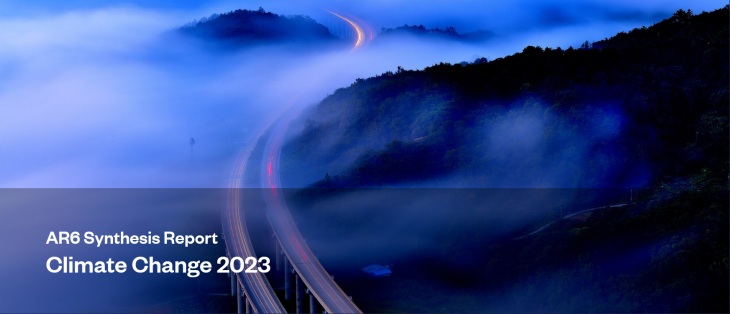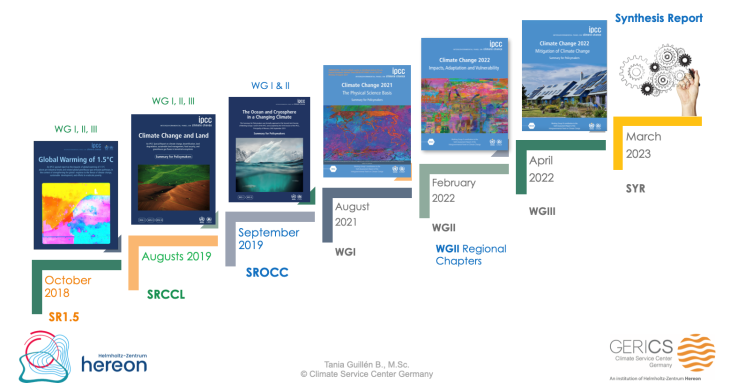IPCC’s Synthesis Report: Call for Immediate Action

Screenshot: IPCC AR6 Synthesis Report
Today, the Intergovernmental Panel on Climate Change (IPCC) released the Synthesis Report (SYR) of its Sixth Assessment cycle (AR6). The synthesis report is the last report of the most active cycle of the IPCC. It brings together the findings from the special reports and the reports of the three Working Groups.
The IPCC is the United Nations scientific body that assesses the science related to climate change. It was created in 1988 with assessment cycles of every 5 - 7 years. The work of the IPCC is mainly distributed into three working groups: Working Group I, related to the physical science basis of climate change; Working Group II, related to impacts, adaptation, and vulnerability; and Working Group III, related to mitigation of climate change.
The IPCC reports are not policy prescriptive, but they are policy relevant. Prove of this is that the United Nations Framework Convention on Climate Change (UNFCCC) milestones can be mapped together with the publication of each of the assessment cycles. In fact, the UNFCCC was agreed upon in 1992, after the publication of the first IPCC report in 1990. Another example is that the publication of the Third Assessment Report (TAR) led to more work on adaptation under the UNFCCC as it highlighted the need to adapt to current (and not only projected) climate change.
Synthesis Report: Selected key messages from the Summary for Policy Makers
- “Human activities, principally through emissions of greenhouse gases, have unequivocally caused global warming, with global surface temperature reaching 1.1°C above 1850–1900 in 2011–2020. Global greenhouse gas emissions have continued to increase, with unequal historical and ongoing contributions arising from unsustainable energy use, land use and land-use change, lifestyles and patterns of consumption and production across regions, between and within countries, and among individuals (high confidence).”
- “Human-caused climate change is already affecting many weather and climate extremes in every region across the globe. This has led to widespread adverse impacts and related losses and damages to nature and people (high confidence). Vulnerable communities who have historically contributed the least to current climate change are disproportionately affected (high confidence).”
- “Adaptation planning and implementation has progressed across all sectors and regions, with documented benefits and varying effectiveness. Despite progress, adaptation gaps exist, and will continue to grow at current rates of implementation. Hard and soft limits to adaptation have been reached in some ecosystems and regions. Maladaptation is happening in some sectors and regions. Current global financial flows for adaptation are insufficient for, and constrain implementation of, adaptation options, especially in developing countries (high confidence).
- “Policies and laws addressing mitigation have consistently expanded since AR5. Global GHG emissions in 2030 implied by nationally determined contributions (NDCs) announced by October 2021 make it likely that warming will exceed 1.5°C during the 21st century and make it harder to limit warming below 2°C. There are gaps between projected emissions from implemented policies and those from NDCs and finance flows fall short of the levels needed to meet climate goals across all sectors and regions. (high confidence).”
- “Continued greenhouse gas emissions will lead to increasing global warming, with the best estimate of reaching 1.5°C in the near term in considered scenarios and modelled pathways. Every increment of global warming will intensify multiple and concurrent hazards (high confidence). Deep, rapid, and sustained reductions in greenhouse gas emissions would lead to a discernible slowdown in global warming within around two decades, and also to discernible changes in atmospheric composition within a few years (high confidence).”
- “For any given future warming level, many climate-related risks are higher than assessed in AR5, and projected long-term impacts are up to multiple times higher than currently observed (high confidence). Risks and projected adverse impacts and related losses and damages from climate change escalate with every increment of global warming (very high confidence). Climatic and non-climatic risks will increasingly interact, creating compound and cascading risks that are more complex and difficult to manage (high confidence).”
-“Adaptation options that are feasible and effective today will become constrained and less effective with increasing global warming. With increasing global warming, losses and damages will increase and additional human and natural systems will reach adaptation limits. Maladaptation can be avoided by flexible, multi-sectoral, inclusive, long-term planning and implementation of adaptation actions, with co-benefits to many sectors and systems. (high confidence).”
- “Climate change is a threat to human well-being and planetary health (very high confidence). There is a rapidly closing window of opportunity to secure a liveable and sustainable future for all (very high confidence). Climate resilient development integrates adaptation and mitigation to advance sustainable development for all, and is enabled by increased international cooperation including improved access to adequate financial resources, particularly for vulnerable regions, sectors and groups, and inclusive governance and coordinated policies (high confidence). The choices and actions implemented in this decade will have impacts now and for thousands of years (high confidence).”
- “Deep, rapid and sustained mitigation and accelerated implementation of adaptation actions in this decade would reduce projected losses and damages for humans and ecosystems (very high confidence), and deliver many co-benefits, especially for air quality and health (high confidence). Delayed mitigation and adaptation action would lock-in high-emissions infrastructure, raise risks of stranded assets and cost-escalation, reduce feasibility, and increase losses and damages (high confidence). Near-term actions involve high up-front investments and potentially disruptive changes that can be lessened by a range of enabling policies (high confidence).”
- “Accelerated and equitable action in mitigating and adapting to climate change impacts is critical to sustainable development. Mitigation and adaptation actions have more synergies than trade-offs with Sustainable Development Goals. Synergies and trade-offs depend on context and scale of implementation. (high confidence).”
- “Prioritising equity, climate justice, social justice, inclusion and just transition processes can enable adaptation and ambitious mitigation actions and climate resilient development. Adaptation outcomes are enhanced by increased support to regions and people with the highest vulnerability to climatic hazards. Integrating climate adaptation into social protection programs improves resilience. Many options are available for reducing emission-intensive consumption, including through behavioural and lifestyle changes, with co-benefits for societal well-being. (high confidence)”
The Sixth Assessment cycle (AR6)
The current (6th) cycle, ending this Monday, has been the most productive one, with three special reports, a refinement to a methodological report, the three Working Group reports, and the synthesis report (see Figure 1).

Figure 1. IPCC’s Sixt Assessment Cycle. © GERICS/Guillén, T.
The AR6 started with the Special Report on Global Warming of 1.5ºC (SR1.5), released in October 2018. The SR1.5 is a unique report in different ways. First, initially, it was not part of the cycle. However, the COP21 invited the IPCC to prepare a report related to the emissions pathways and the impacts of the lower limit (1.5ºC) of the Paris Agreement. Until then, little information about it was available. Second, it was the first report co-produced by the three Working Groups. Third, it was produced in a record time (less than two years) so that parties of the UNFCCC could consider it during the COP24 negotiations. The report made clear that it was still possible to limit global warming to 1.5ºC (the most ambitious limit of the Paris Agreement), reducing the risks to society and ecosystems.
In 2019, two more special reports were published: the Special Report on Climate Change and Land (SRCCL), and the Special Report on the Ocean and Cryosphere in a Changing Climate (SROCC). Both reports reinforced the need for ambitious climate action to reduce the pressures on the ecosystems to preserve their capacities to face the effects of global warming.
The Working Group contributions to the AR6 were published between August 2021 and April 2022. Below, we share some of the most important findings from the different reports:
WGI: The Physical Science Basis
-“Recent changes in the climate are widespread, rapid, and intensifying, and unprecedented in thousands of years”;
- “Climate change is already affecting every region on Earth, in multiple ways. The changes we experience will increase with further warming”;
- “To limit global warming, strong, rapid, and sustained reductions in CO2, methane, and other greenhouse gases are necessary. This would not only reduce the consequences of climate change but also improve air quality.”
WGII: Impacts, Adaptation and Vulnerability
- “The scientific evidence is unequivocal: climate change is a threat to human well-being and the health of the planet.
- Any further delay in concerted global action will miss the brief, rapidly closing window to secure a liveable future.”
WGIII: Mitigation
-“Average annual greenhouse gas emissions at the highest levels in human history” (Period 2010-2019)”
-“We are not in track to limit warming to 1.5ºC, but there is increased evidence of climate action”
- However, “unless there are immediate and deep emissions reductions across all sectors, 1.5ºC is beyond reach”.
GERICS’ involvement in the AR6
GERICS scientists have been involved in this assessment cycle in different roles:
- Special report on Global warming of 1.5ºC (2018): Prof. Dr. Daniela Jacob, GERICS director, was Coordinating Lead Author of Chapter 3 on impacts of global warming of 1.5ºC on natural and human systems. Additionally, Tania Guillén Bolaños, GERICS scientist, was Chapter Scientist and Contributing Author of the same chapter. Prof. Jacob and Ms. Guillén Bolaños were drafting authors for the Summary for Policymakers. GERICS experts Dr. Swantje Preuschmann and Juliane Petersen were Contributing Authors of the same chapter.
- Special Report on the Ocean and Cryosphere in a Changing Climate (2019): Dr. Laurens Bouwer, GERICS senior scientist, was Lead Author of Chapter 6 on Extremes, Abrupt Changes and Managing Risks.
- Working Group I on the Physical Science Basis (2021): Dr. Claas Teichmann, GERICS senior scientist, was contributing author of Chapter 12 on the WGI’s Atlas.
- Working Group II on Impacts, vulnerability and adaptation (2022): Dr. Laurens Bouwer was Contributing Author for the Cross Chapter Box on Loss and Damage, as part of Chapter 18. Additionally, Tania Guillén, GERICS scientist, was contributing author for the Cross Chapter Box on the Feasibility Assessment of Adaptation Options (also part of Chapter 18).
Publications by GERICS related to the IPCC reports
- Hoegh-Guldberg, O., Jacob, D., Taylor, M., Guillén Bolaños, T., Bindi, M., Brown, S., et al. (2019). The human imperative of stabilizing global climate change at 1.5ºC. Science. 365. https://www.science.org/doi/10.1126/science.aaw6974
- Jacob, D., Blome, T., Guillén Bolaños, T., Petersen, J., Preuschmann, S., and Steuri, B. (2019). The report on 1.5°C global warming-relevant aspects for climate services. Clim. Serv. 15, 100105. https://doi.org/10.1016/j.cliser.2019.100105
- Bouwer, L.M. et al. 2022. Risk management and adaptation for extremes and abrupt changes in climate and oceans: current knowledge gaps. Frontiers in Climate, 3, 785641. https://doi.org/10.3389/fclim.2021.785641
